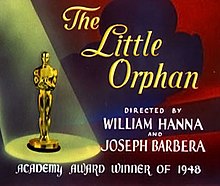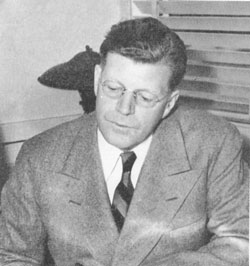
Frederick Clinton Quimby was an American animation producer and journalist best known for producing the Tom and Jerry cartoon series, for which he won seven Academy Awards for Best Animated Short Films. He was the film sales executive in charge of the Metro-Goldwyn-Mayer cartoon studio, which included Tex Avery, Droopy, Butch Dog, Barney Bear, Michael Lah and multiple one-shot cartoons, as well as William Hanna and Joseph Barbera, the creators of Tom and Jerry.

The Cat Concerto is a 1947 American one-reel animated cartoon and the 29th Tom and Jerry short, released to theatres on April 26, 1947. It was produced by Fred Quimby and directed by William Hanna and Joseph Barbera, with musical supervision by Scott Bradley, and animation by Kenneth Muse, Ed Barge and Irven Spence and uncredited animation by Don Patterson.
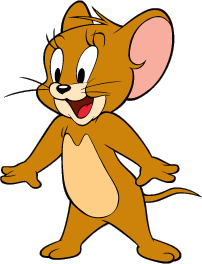
Gerald Jinx "Jerry" Mouse is a fictional character and one of the two titular characters in Metro-Goldwyn-Mayer's series of Tom and Jerry theatrical animated short films and other animated media, usually acting as the protagonist opposite his rival Tom Cat. Created by William Hanna and Joseph Barbera, Jerry is an anthropomorphic brown house mouse, who first appeared as a mouse named Jinx in the 1940 MGM animated short Puss Gets the Boot. Hanna gave the mouse's original name as "Jinx", while Barbera claimed the mouse went unnamed in his first appearance.
Tom and Jerry is an American animated media franchise and series of comedy short films created in 1940 by William Hanna and Joseph Barbera. Best known for its 161 theatrical short films by Metro-Goldwyn-Mayer, the series centers on the rivalry between the titular characters of a cat named Tom and a mouse named Jerry. Many shorts also feature several recurring characters.
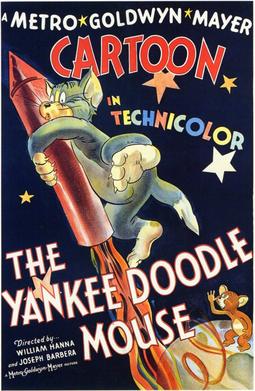
The Yankee Doodle Mouse is a 1943 American one-reel animated cartoon in Technicolor. It is the eleventh Tom and Jerry short produced by Fred Quimby, and directed by William Hanna and Joseph Barbera, with musical supervision by Scott Bradley and animation by Irven Spence, Pete Burness, Kenneth Muse and George Gordon. Jack Zander was credited on the original print, but his credit was omitted in the 1950 reissue. It was released to theaters on June 26, 1943 by Metro-Goldwyn Mayer. The short features Tom the cat and Jerry the mouse chasing each other in a pseudo-warfare style, and makes numerous references to World War II technology such as jeeps and dive bombers, represented by clever uses of common household items. The Yankee Doodle Mouse won the 1943 Oscar for Best Animated Short Film, making it the first of seven Tom and Jerry cartoons to receive this distinction.

Puss Gets the Boot is a 1940 American animated short film and is the first short in what would become the Tom and Jerry cartoon series, though neither are yet referred to by these names. It was directed by William Hanna and Joseph Barbera, and produced by Rudolf Ising. It is based on the Aesop's Fable, The Cat and the Mice. As was the practice of MGM shorts at the time, only Rudolf Ising is credited. It was released to theaters on February 10, 1940, by Metro-Goldwyn-Mayer.
Johann Mouse is a 1953 American one-reel animated cartoon and the 75th Tom and Jerry cartoon, released in theaters on March 21, 1953 by Metro-Goldwyn-Mayer. The short is directed by William Hanna and Joseph Barbera, composed by Scott Bradley, and animated by Kenneth Muse, Ray Patterson, Ed Barge, and Irven Spence. It won the 1952 Academy Award for Best Short Subject: Cartoons, the seventh and last Oscar given to a Tom and Jerry short.
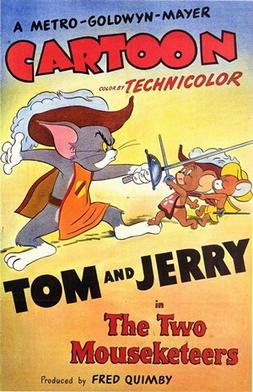
The Two Mouseketeers is a 1952 American one-reel animated cartoon and is the 65th Tom and Jerry short, produced in Technicolor and released to theatres on March 15, 1952 by Metro-Goldwyn-Mayer. It was produced by Fred Quimby and directed by William Hanna and Joseph Barbera. The short is a spoof of Alexandre Dumas' 1844 novel The Three Musketeers and its film adaptations, featuring the mice Jerry and his best friend, Nibbles as the "Mouseketeers" trying to raid the French king's banquet table, which is protected by Tom as a guard. Three years after the cartoon's release, the term "Mousketeer" was also used to refer to the child cast members of the television show, The Mickey Mouse Club.

Tom and Jerry: The Magic Ring is a 2002 American animated fantasy comedy film. Produced by Warner Bros. Animation and Turner Entertainment Co., it was the first direct-to-video attempt to recapture the style of William Hanna and Joseph Barbera's original film shorts from Metro-Goldwyn-Mayer as well as the final animated collaboration of both Hanna and Barbera, as Hanna died on March 22, 2001. It was directed by James Tim Walker, written by Tim Cahill & Julie McNally, produced by Tom Minton, and edited by Bradford H. Keatts.

Mouse Trouble is a 1944 American one-reel animated cartoon short and is the 17th Tom and Jerry short produced by Fred Quimby. It was directed by William Hanna and Joseph Barbera, with music direction by Scott Bradley. The cartoon was animated by Ray Patterson, Irven Spence, Ken Muse and Pete Burness. Mouse Trouble won the 1944 Oscar for Best Animated Short Film, the second consecutive award bestowed upon the series. It was released in theatres on November 23, 1944 by Metro-Goldwyn Mayer and reissued on December 12, 1951.
The Night Before Christmas is a 1941 American one-reel animated cartoon and is the third Tom and Jerry short directed by William Hanna and Joseph Barbera, produced by Fred Quimby and animated by Jack Zander, George Gordon, Irven Spence and Bill Littlejohn. It was nominated for the 1941 Academy Award for Best Short Subject: Cartoons, but lost to the Mickey Mouse short film Lend a Paw, making it the only Tom and Jerry cartoon to lose to a Disney film.

The Metro-Goldwyn-Mayer cartoon studio was an American animation studio operated by Metro-Goldwyn-Mayer (MGM) during the Golden Age of American animation. Active from 1937 until 1957, the studio was responsible for producing animated shorts to accompany MGM feature films in Loew's Theaters, which included popular cartoon characters Tom, Jerry, Droopy, Butch, Spike, Tyke, and Barney Bear.
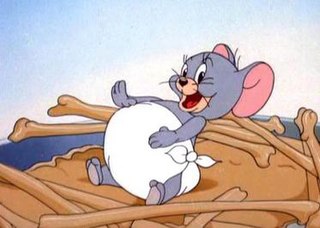
Nibbles is a fictional character from the Tom and Jerry cartoon series. He is the little, blue/gray, diaper-wearing orphan mouse whose cartoon debut came in the 1946 short The Milky Waif. Tuffy was later featured in the 1949 Academy Award-winning short The Little Orphan, as well as Two Little Indians and The Two Mouseketeers.

Tot Watchers is a 1958 American one-reel animated Tom and Jerry short produced and directed by William Hanna and Joseph Barbera with music by Scott Bradley. The short was released by Metro-Goldwyn-Mayer on August 1, 1958. It is the 114th and last Tom and Jerry theatrical cartoon produced or directed by both Hanna and Barbera, and the last cartoon short of the series until Gene Deitch's Switchin' Kitten in 1961. Barbera would return to direct one final Tom and Jerry theatrical short, The Karate Guard, in 2005.
Tee for Two is a 1945 American one-reel Technicolor animated cartoon and is the 20th Tom and Jerry short, first released to theaters on July 21, 1945, by Metro-Goldwyn-Mayer. The short is directed by William Hanna and Joseph Barbera, composed by Scott Bradley, and animated by Ray Patterson, Irven Spence, Pete Burness, and Kenneth Muse.
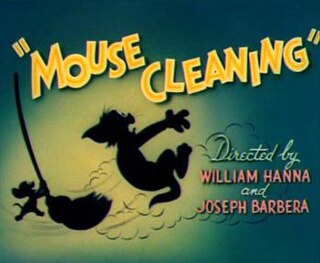
Mouse Cleaning is a 1948 one-reel animated cartoon and the 38th Tom and Jerry short. The title is a play on "house cleaning". It was produced in Technicolor and released to theatres on December 11, 1948, by Metro-Goldwyn Mayer and again on February 18, 1956. It was animated by Irven Spence, Kenneth Muse, Ed Barge and Ray Patterson, who were the usual animators for the Tom and Jerry cartoons in the early 1940s up until the late 1950s. It was directed by William Hanna and Joseph Barbera, and produced by Fred Quimby; no writer has yet been credited. The music was scored by Scott Bradley and the backgrounds were created by Robert Gentle.
Raymond Patterson was an American animator, producer, and director. He was born in Hollywood, California, and was the younger brother of animator Don Patterson.
Irven LeRoy Spence was an American animator. He is best known for his work on MGM's Tom and Jerry animated shorts. Spence has been credited variously as Irven Spence, Irvin Spence, and Irv Spence.

Casanova Cat is a 1951 one-reel animated cartoon and is the 55th Tom and Jerry short directed by William Hanna and Joseph Barbera and produced by Fred Quimby.

The Karate Guard is a 2005 American animated cartoon short film, and the 163rd Tom and Jerry short. Directed by Joseph Barbera and Spike Brandt, The Karate Guard was the last Tom and Jerry cartoon that Barbera worked on before his death in 2006. It had a limited theatrical release in cinemas throughout Los Angeles on September 27, 2005 by Warner Bros. Pictures, and had its television premiere on Cartoon Network on January 27, 2006.
